| An Inventory of Marx Playset Figures and Accessories Manufactured from 1951 to 1979 Wild West Page 3 - 54mm Figures |
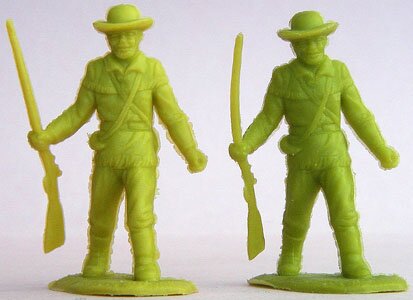 see that Marx actually produced the figures in at least two different shades of green (whether on purpose or simply by accident, I am not sure). As shown at right (if your computer is able to handle the color difference), the figure on the left is a light yellow green (lime), while the one of the right is a slighty darker pea soup green. If you buy a few of these guys from different Comanche Pass Play Sets, you should be able to see the difference much more clearly.
see that Marx actually produced the figures in at least two different shades of green (whether on purpose or simply by accident, I am not sure). As shown at right (if your computer is able to handle the color difference), the figure on the left is a light yellow green (lime), while the one of the right is a slighty darker pea soup green. If you buy a few of these guys from different Comanche Pass Play Sets, you should be able to see the difference much more clearly.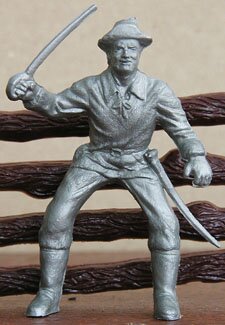 |
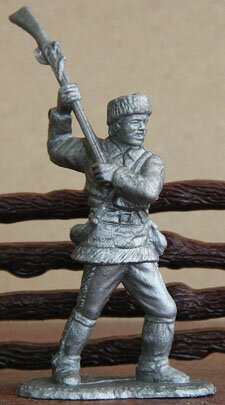 |
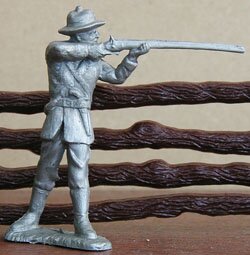 |
| 1. Mounted, with sword | 2. Clubbing with rifle (unofficial Davy Crockett) |
3. Standing, firing rifle |
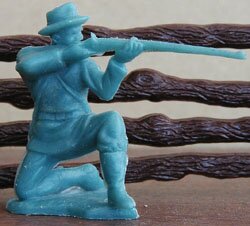 |
 |
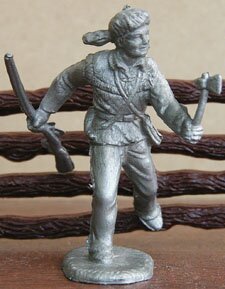 |
| 4. Kneeling, firing rifle | 5. Advancing with sword and bugle | 6. Running, rifle in right hand |
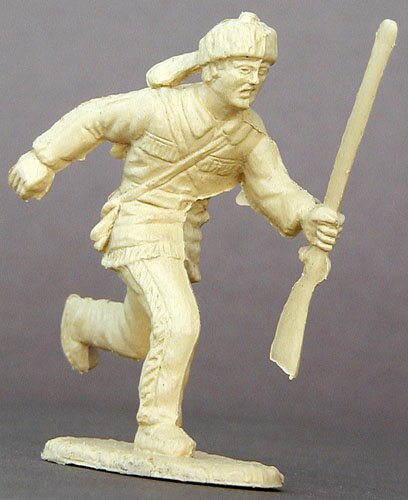 |
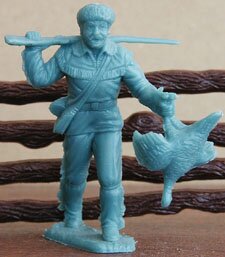 |
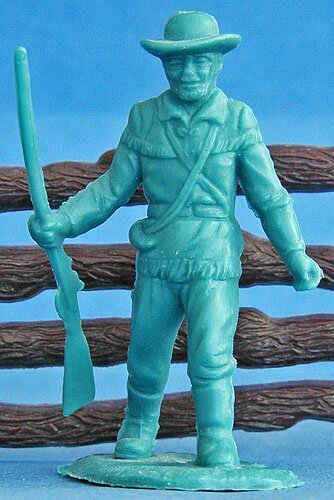 |
| 7. Running, rifle in left hand | 8. Walking with turkey | 9. Walking with rifle |
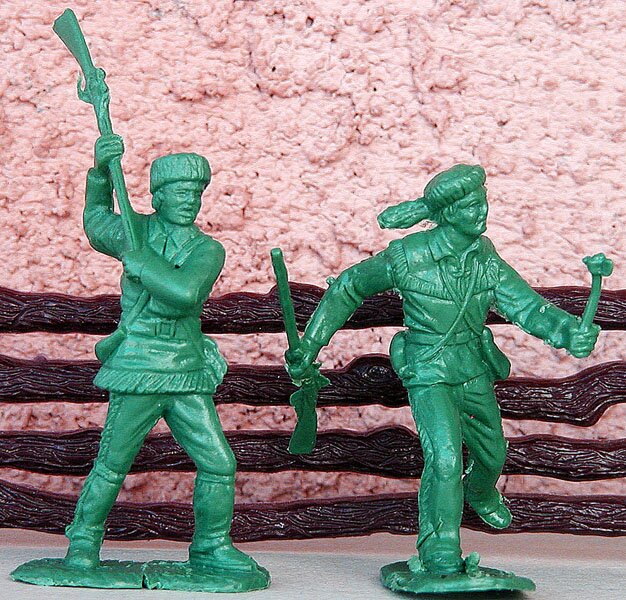 |
| Hard plastic re-issue figures in green Note tiny head on axe of figure on right. |

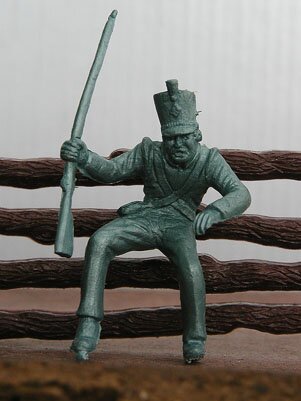 |
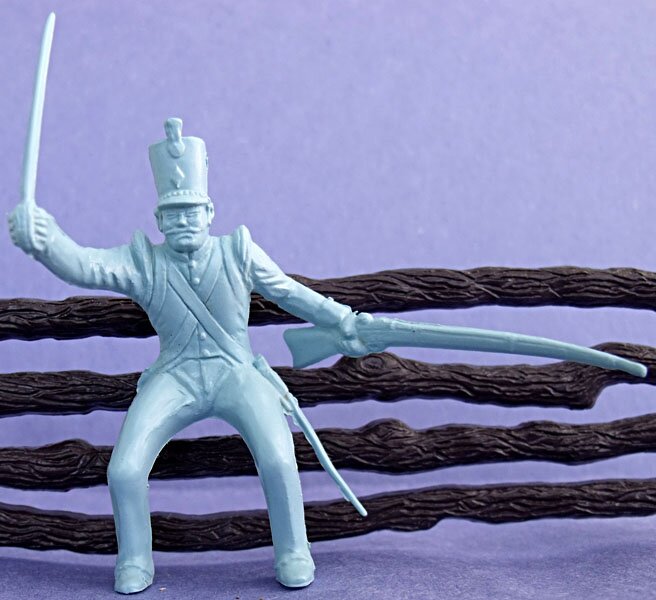 |
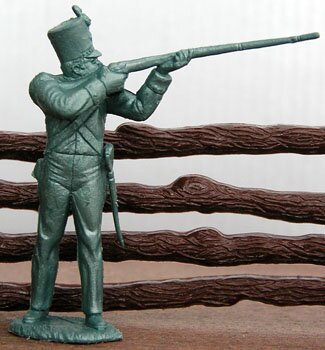 |
| 1. Climbing over wall with rifle | 2. Mounted with sword and rifle | 3. Standing, firing rifle |
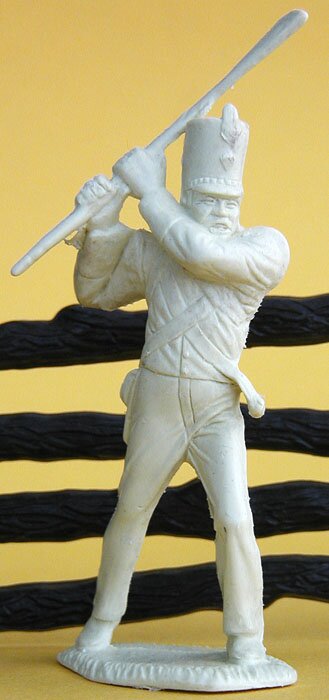 |
 |
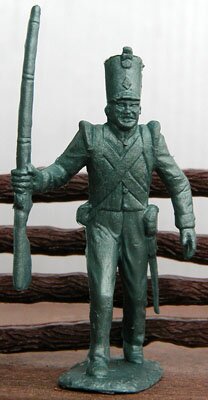 |
| 4. Clubbing with rifle (in the more expensive cream color) |
5. Advancing with bayonet | 6. Walking with rifle in right hand |
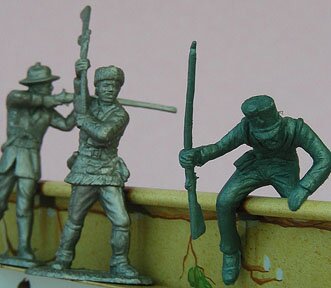 |
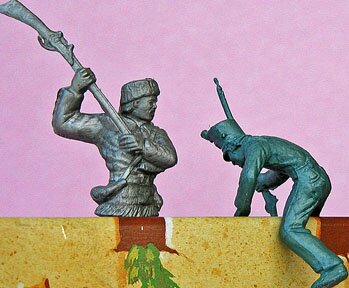 |
| Correct placement for Pose 1, climbing the wall with legs straddling the top of the wall and left hand on wall, based on collector John Pyle's input. I don't know if Marx intended it that way or not, but he fits perfectly in this position. | |

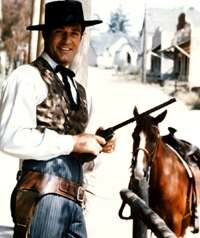 This lone 54mm Wyatt Earp figure was included in Wyatt Earp Dodge City Western Town playsets first sold, according to Playset Magazine Issue 66, by Montogonery Wards in 1957 and the following year by both Wards and Speigel's. The playset was based on the television program The Life and Legend of Wyatt Earp, which lasted from 1955 to 1961. The Marx figure is an excellent representation of Hugh O'Brian, who played the role on the show, and looks nothing like the real Wyatt Earp. The figure is holding a Buntline special used by Earp on the television program, a .45 pistol with an extra-long barrel for extra power and accuracy. Some historians believe Wyatt actually used this long-barreled weapon that journalist Ned Buntline had made specifically for him and other legendary wild west notables, but others believe that such a pistol never existed.
This lone 54mm Wyatt Earp figure was included in Wyatt Earp Dodge City Western Town playsets first sold, according to Playset Magazine Issue 66, by Montogonery Wards in 1957 and the following year by both Wards and Speigel's. The playset was based on the television program The Life and Legend of Wyatt Earp, which lasted from 1955 to 1961. The Marx figure is an excellent representation of Hugh O'Brian, who played the role on the show, and looks nothing like the real Wyatt Earp. The figure is holding a Buntline special used by Earp on the television program, a .45 pistol with an extra-long barrel for extra power and accuracy. Some historians believe Wyatt actually used this long-barreled weapon that journalist Ned Buntline had made specifically for him and other legendary wild west notables, but others believe that such a pistol never existed.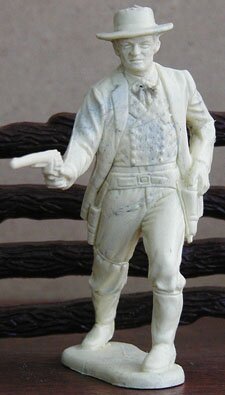 |
| 1. Wyatt Earp |
| Recent Price Lines I have noticed | ||||
| Wyatt Earp figure | $62 | May 2011 | Ebay | |

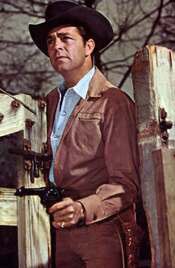
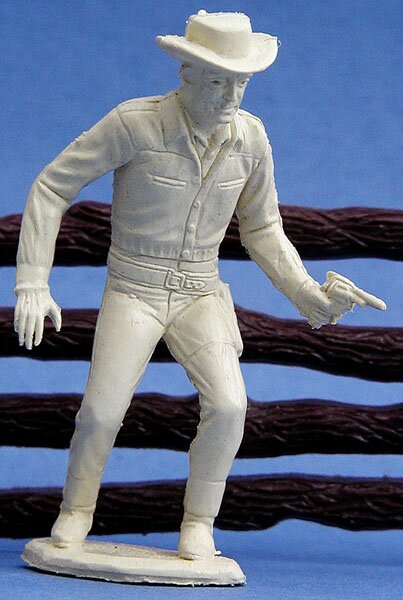 |
|
1. Jim Hardie
|
| Recent Price Lines I Have Noticed | ||||
| $125 | April 2011 | Ebay | high bid | |
| $52 | April 2011 | Ebay | A good deal for the buyer! | |
| $66 | June 2011 | Ebay | good condition | |
| $123 | June 2011 | Ebay | Price seems to be all over the place! | |
| $56 | Sept 2011 | Ebay | good price for buyer | |
| $74 | Sept 2011 | Ebay | ||
| $65 | Sept 2012 | Ebay | ||

 shades of butterscotch, other shades of brown, and a color that collectors call red wine.
shades of butterscotch, other shades of brown, and a color that collectors call red wine.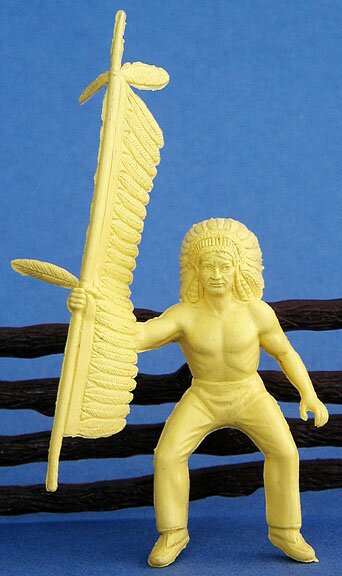 |
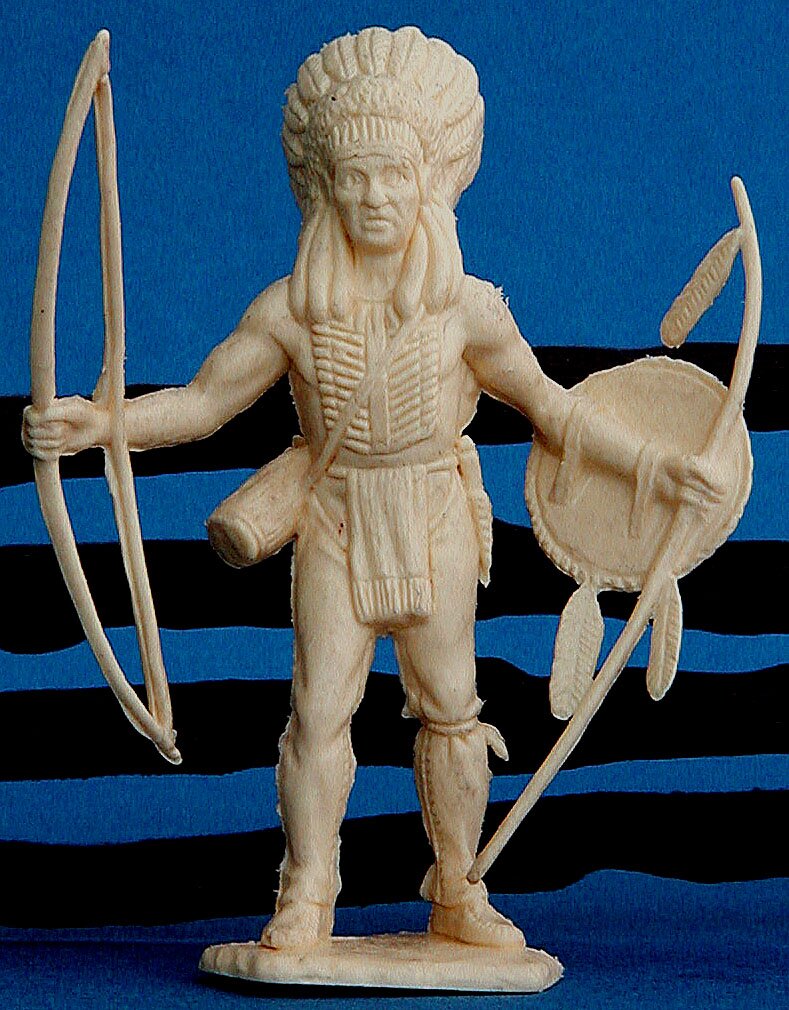 |
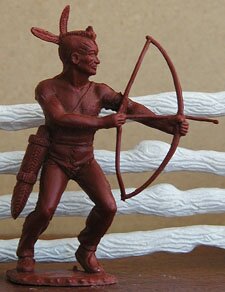 |
| 1. Mounted with feathered lance | 2. Standing, holding bow and lance | 3. Standing, shooting bow |
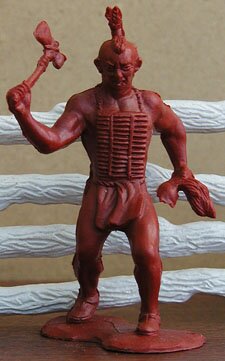 |
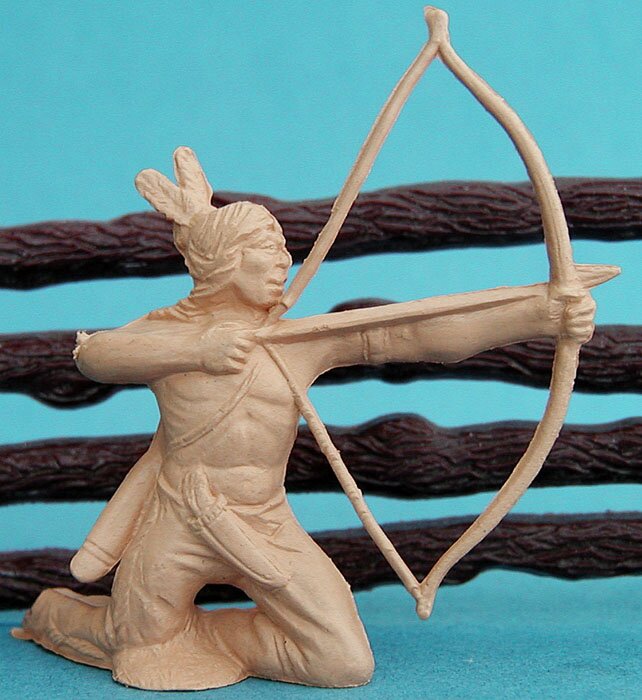 |
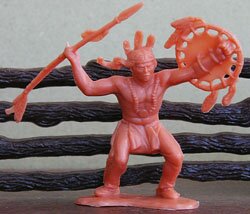 |
| 4. Walking with tomahawk and scalp | 5. Kneeling, shooting bow | 6. Standing with lance and shield |
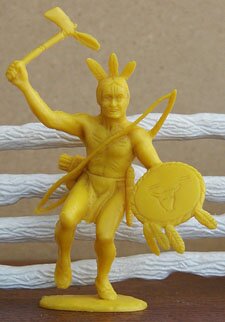 |
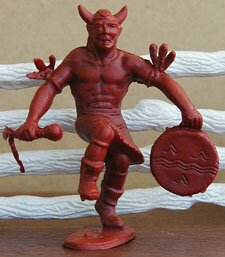 |
 |
| 7. Running with tomahawk and shield | 8. Dancing with drum | 9. Running with club |
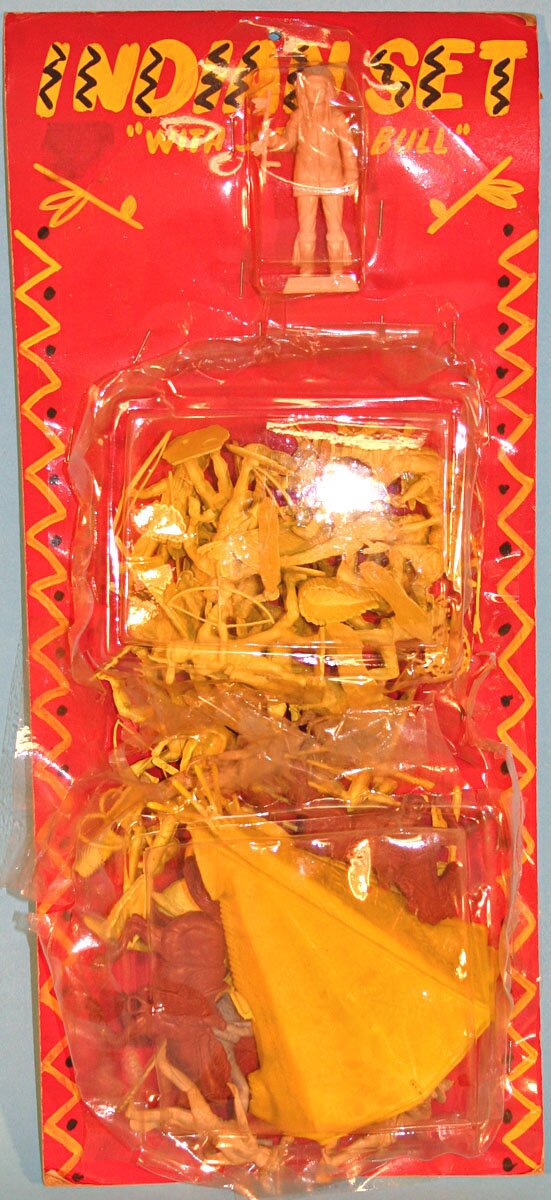 |
||
| Blister card of 54mm Indians with tepee (made in same mold) and 60mm Sitting Bull. Photo courtesy of Mark Hegeman. |

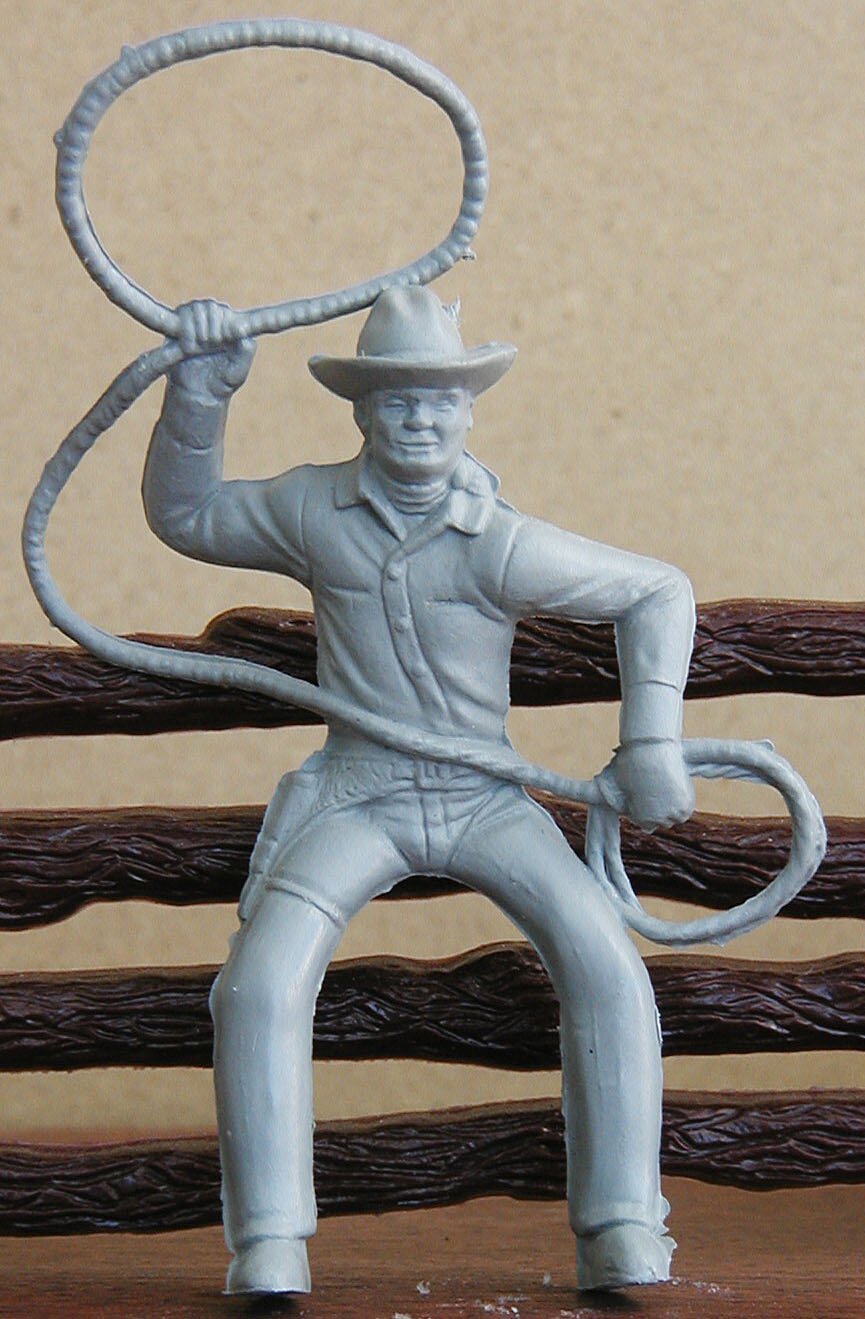 |
 |
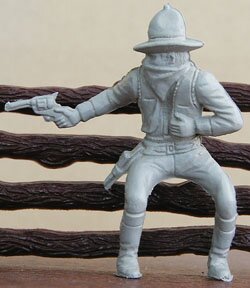 |
| 1. Mounted, with lasso | 2. Mounted sheriff, pistol in right hand | 3. Mounted outlaw |
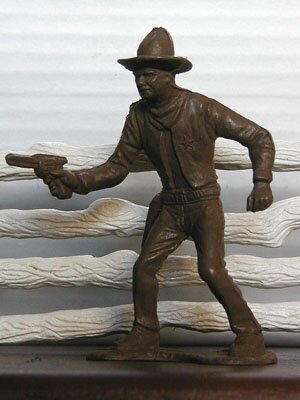 |
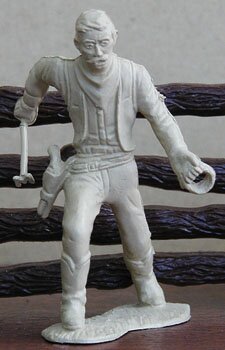 |
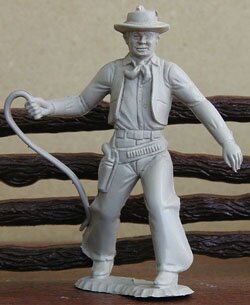 |
| 4. Standing sheriff, pistol in right hand | 5. With branding iron and rope | 6. Standing with whip |
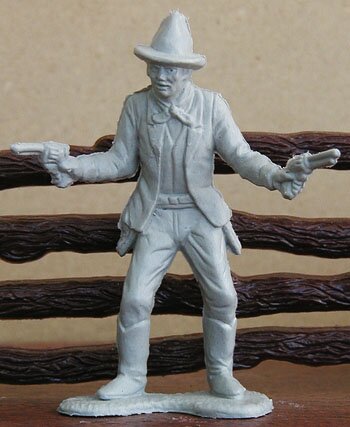 |
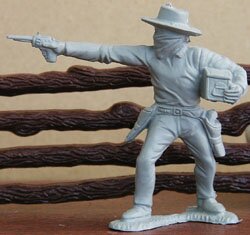 |
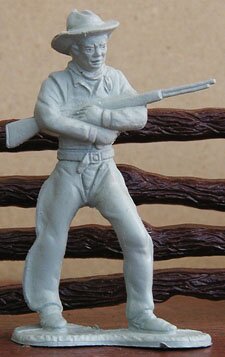 |
| 7. Standing with two pistols drawn | 8. Standing outlaw | 9. Standing, rifle held across chest |
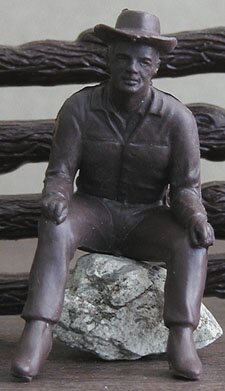 |
| 10. Wagon driver |

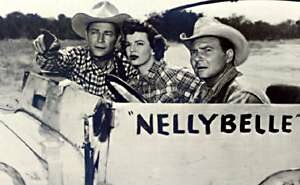 In 1957, Marx introduced this new 54mm group of Roy Rogers character figures. The characters are the same people as the 60mm group, but the mounted Roy is now brandishing his pistol, Dale is waving, and Bullet is standing. Pat Brady's hat now seems to be firmly on his head (he was holding it on in his 60mm pose) and he is armed with a hammer in his right hand. The smaller figures were a result of the company's overall downsizing of its playset figures from 60mm to 54mm.
In 1957, Marx introduced this new 54mm group of Roy Rogers character figures. The characters are the same people as the 60mm group, but the mounted Roy is now brandishing his pistol, Dale is waving, and Bullet is standing. Pat Brady's hat now seems to be firmly on his head (he was holding it on in his 60mm pose) and he is armed with a hammer in his right hand. The smaller figures were a result of the company's overall downsizing of its playset figures from 60mm to 54mm.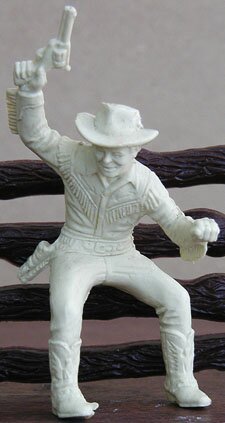 |
 |
| 1. Roy Rogers | 2. Dale Evans |
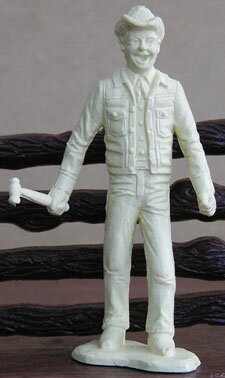 |
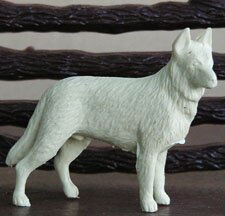 |
| 3. Pat Brady | 4. Bullet |
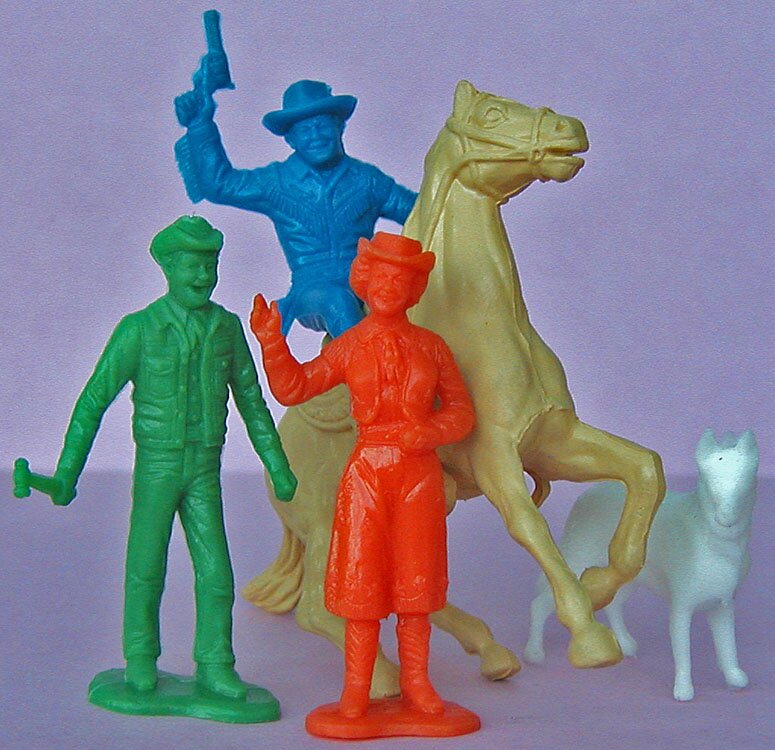 |
| Re-issue figures made in Mexico Horse is original. |
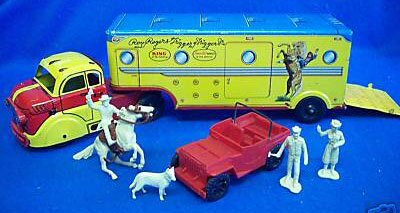 |
| Roy Rogers horse trailer and jeep Nellybelle. The jeep was included in some play sets. The trailer was sold separately. Photo courtesy of Jim McGough |

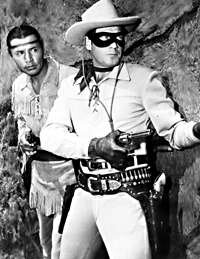 In addition to the three 60mm Lone Ranger character figures included in playsets (see PL-497 on Page 2), Marx produced smaller Lone Ranger and Tonto figures that were available only in 1957 and only as cereal premiums. They were never in playsets or any other store sales. These figures were part of a set of Marx figures and cardboard buildings that could be purchased for 50 cents with a mail-in coupon from a Cheerios box. The Lone Ranger is mounted, but now firing his pistol straight ahead; Tonto is standing with his arms crossed in front of him similar to the 60mm figure, but has no feather in his headband. Tonto's base has his name inscribed on the front of it. Both figures were cream.
In addition to the three 60mm Lone Ranger character figures included in playsets (see PL-497 on Page 2), Marx produced smaller Lone Ranger and Tonto figures that were available only in 1957 and only as cereal premiums. They were never in playsets or any other store sales. These figures were part of a set of Marx figures and cardboard buildings that could be purchased for 50 cents with a mail-in coupon from a Cheerios box. The Lone Ranger is mounted, but now firing his pistol straight ahead; Tonto is standing with his arms crossed in front of him similar to the 60mm figure, but has no feather in his headband. Tonto's base has his name inscribed on the front of it. Both figures were cream.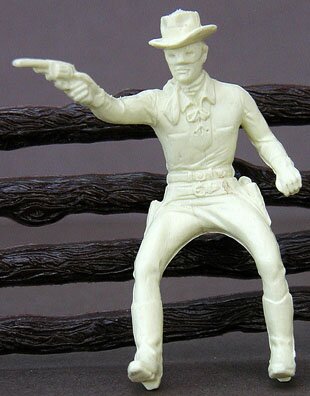 |
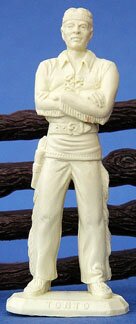 |
| 1. Lone Ranger - cereal premium | 2. Tonto - cereal premium |

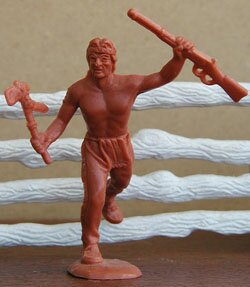 |
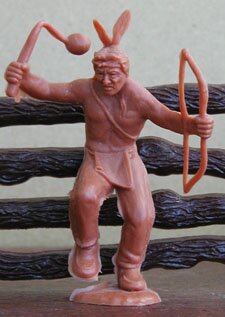 |
| 10. Running with tomahawk and rifle | 11. Running with club and bow |
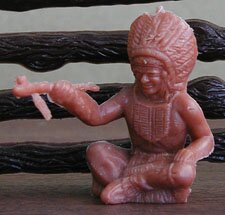 |
 |
| 12. Sitting with peace pipe | 13. Shot with arrow |
 |
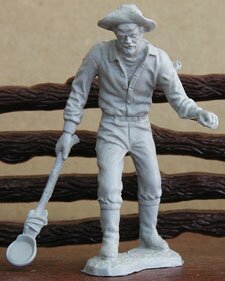 |
|
| 1. Walking with jacket and shovel | 2. Holding pan tied to stick | |
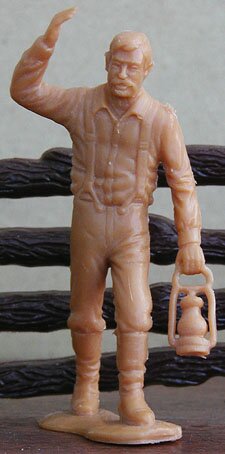 |
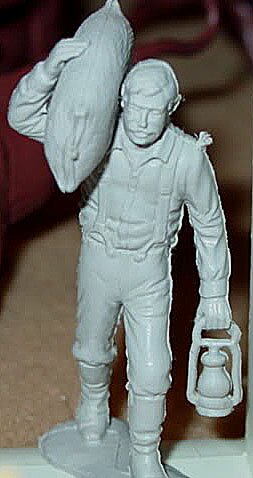 |
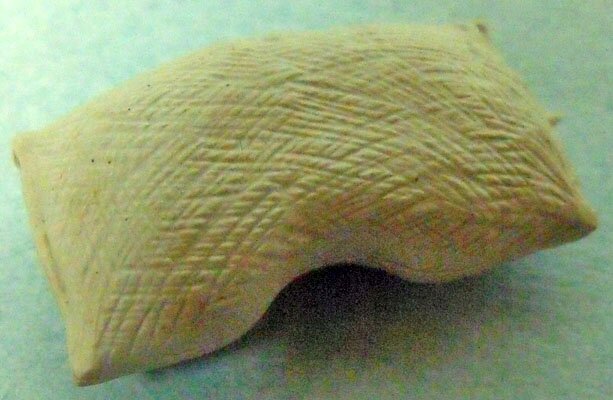 |
| 3. Holding lantern and separate bag Separate bag not shown. |
3. Miner in photo at left with bag Photo courtesy of David Schafer |
That elusive little bag! Photo courtesy of David Schafer |
| Recent price lines I have noticed | ||||
| Miner with bag | $89 | August 2012 | Ebay | |
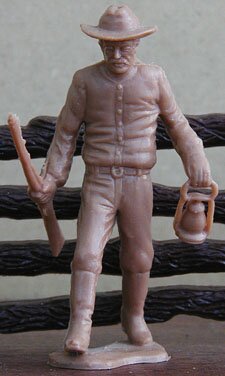 |
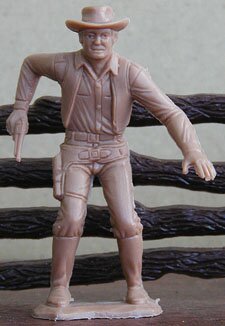 |
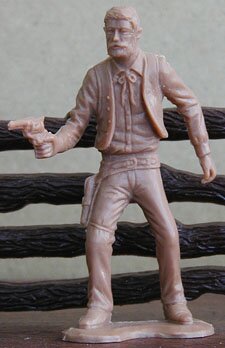 |
| 4. Walking with rifle and lantern | 5. Drawing pistol | 6. Sherriff, pistol in right hand |
 |
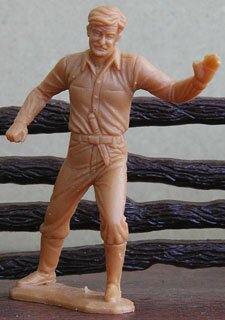 |
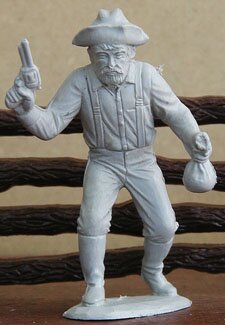 |
| 7. Fighting, hat on | 8. Fighting, no hat | 9. Old man with pistol and bag |
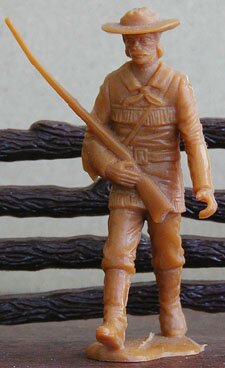 |
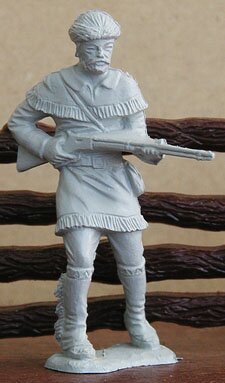 |
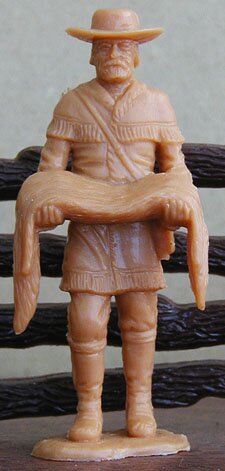 |
| 10. Walking, rifle cradled in right arm | 11. Rifle held at waist | 12. Standing, fur held in arms |
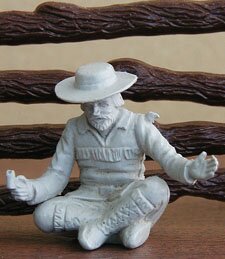 |
| 13. Sitting on ground |

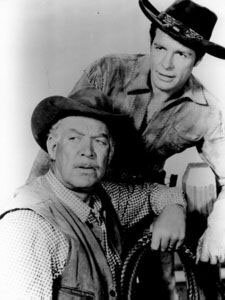
 |
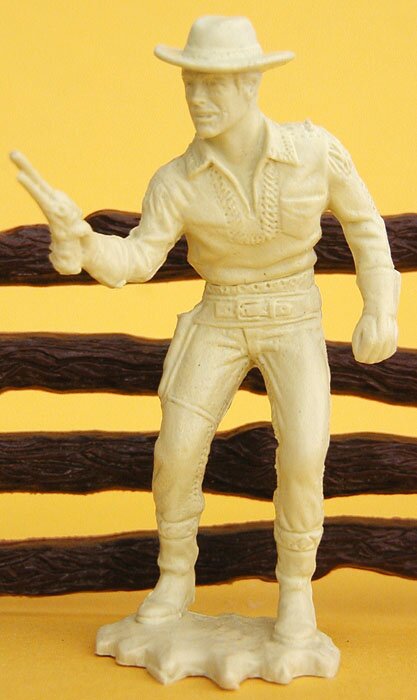 |
| 1. Major Seth Adams | 2. Flint McCullough |
| Recent Price Lines I have noticed | ||||
| Seth Adams | $90 | June 2011 | Ebay | |
| Seth Adams | $160 | June 2011 | Ebay | clean split in rope, high for a broken figure |
| Seth Adams | $200 | June 2011 | Ebay | |
| Seth Adams | $102 | Sept 2011 | Ebay | |
| Seth Adams | $104 | Sept 2011 | Ebay | |
| Seth Adams | $90 | Jan 2012 | Ebay | |
| Seth Adams | $85 | Feb 2012 | Ebay | |
| Seth Adams | $78 | June 2012 | Ebay | |

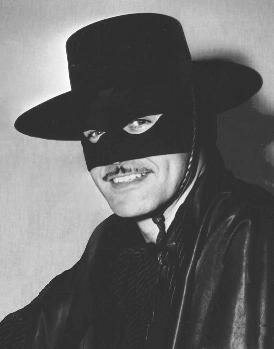 This figure was the centerpiece of Marx' Zorro playsets, which were first sold in 1958. The playsets were based on the television series Zorro, which was produced by Walt Disney. The series lasted only from 1957 to 1958, and the the playsets were featured in Sears' 1958 Christmas catalog and then discontinued. Marx, however, sold Zorro sets again in 1965 when the television series was re-run, and this set (#3758) is the easiest of the Zorro sets to find today.
This figure was the centerpiece of Marx' Zorro playsets, which were first sold in 1958. The playsets were based on the television series Zorro, which was produced by Walt Disney. The series lasted only from 1957 to 1958, and the the playsets were featured in Sears' 1958 Christmas catalog and then discontinued. Marx, however, sold Zorro sets again in 1965 when the television series was re-run, and this set (#3758) is the easiest of the Zorro sets to find today.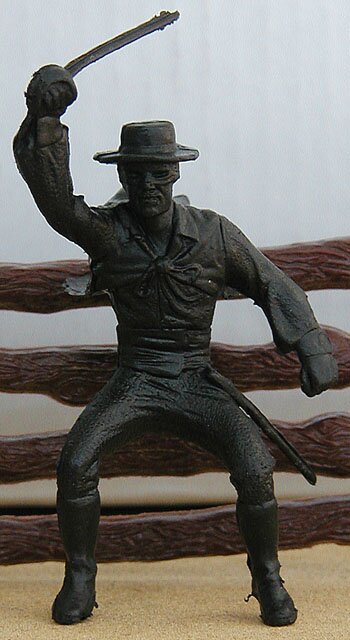 |
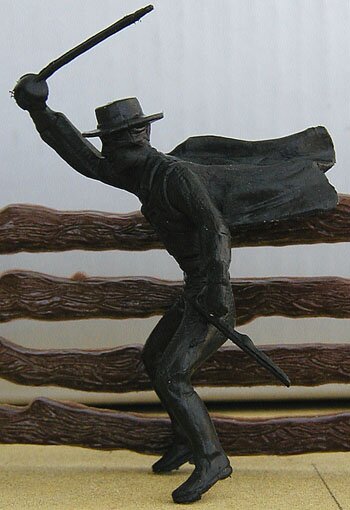 |
| Zorro, front view | Zorro, side view |
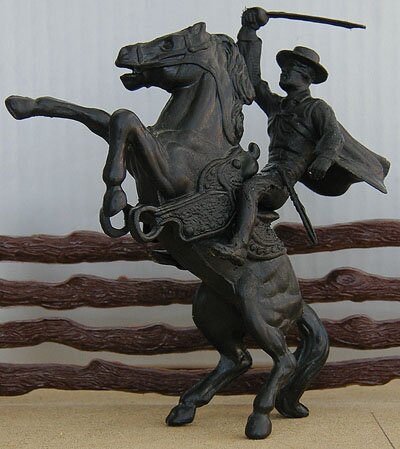 |
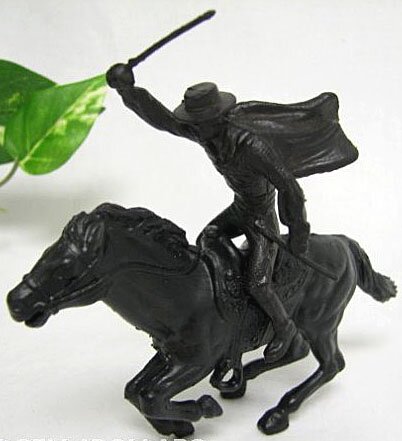 |
| Zorro, mounted on rearing horse | Zorro, mounted on running horse Photo courtesy of E-SELL4DOLLARS on Ebay. |

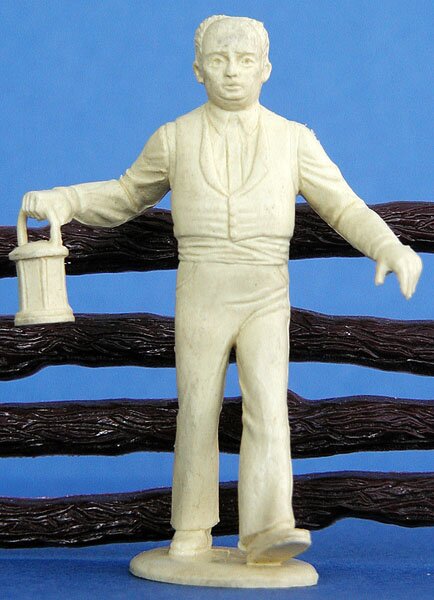 |
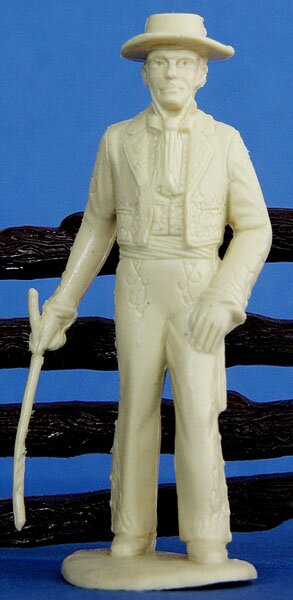 |
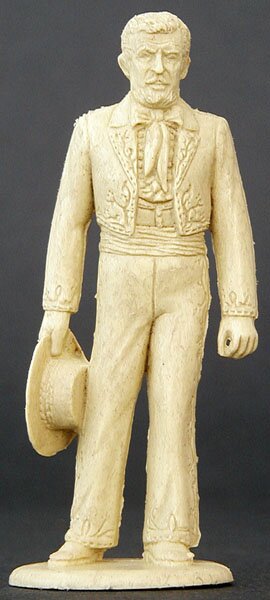 |
| 1. Bernardo | 2. Don Diego | 3. Don Alejandro |
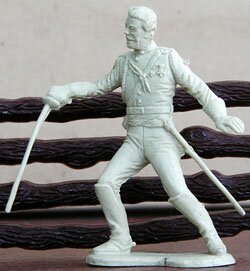 |
 |
| 4. El Commandante | 5. Sergeant Garcia |
| Recent Price Lines I have noticed | ||||
| Don Alejandro | $40 | June 2011 | Ebay | good condition |
| Bernardo | $46 | June 2013 | Ebay | |
| Don Alejandro | $39 | June 2013 | Ebay | |
| Don Diego | $38 | June 2013 | Ebay | |
| El Commandante | $38 | June 2013 | Ebay | |
| Sergeant Garcia | $40 | June 2013 | Ebay | |

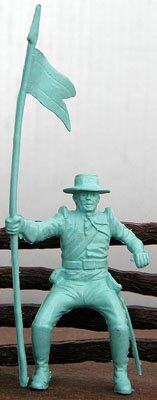 |
 |
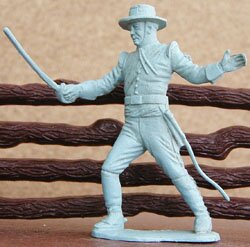 |
| 1. Mounted with lance/flag | 2. Mounted with sword | 3. Standing with sword in fighting position |
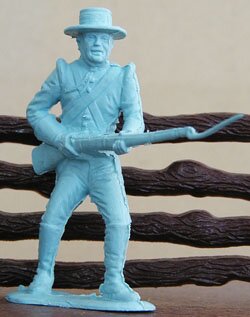 |
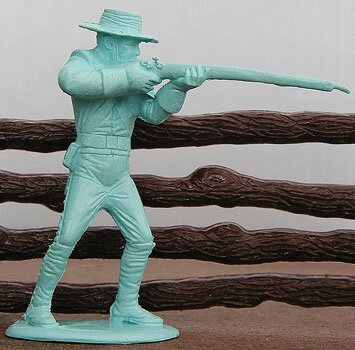 |
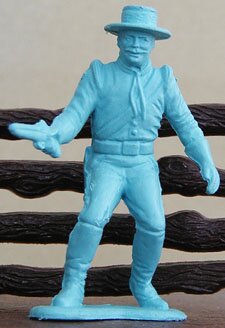 |
| 4. Advancing with bayonet | 5. Standing, firing rifle | 6. Standing with pistol |
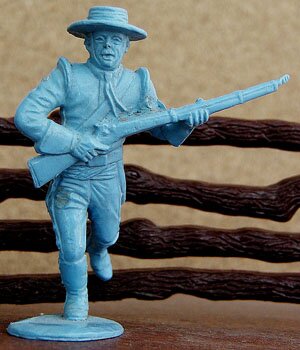 |
 |
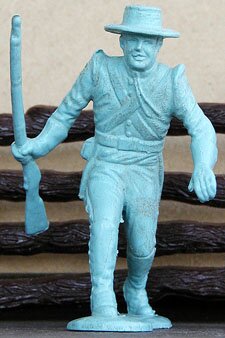 |
| 7. Running with rifle | 8. Standing with sword overhead | 9. Walking with rifle in right hand |
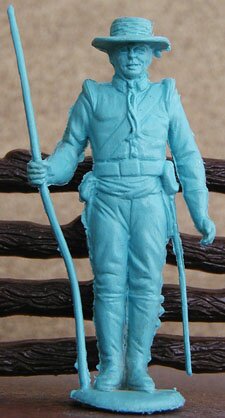 |
| 10. Standing with staff in right hand |

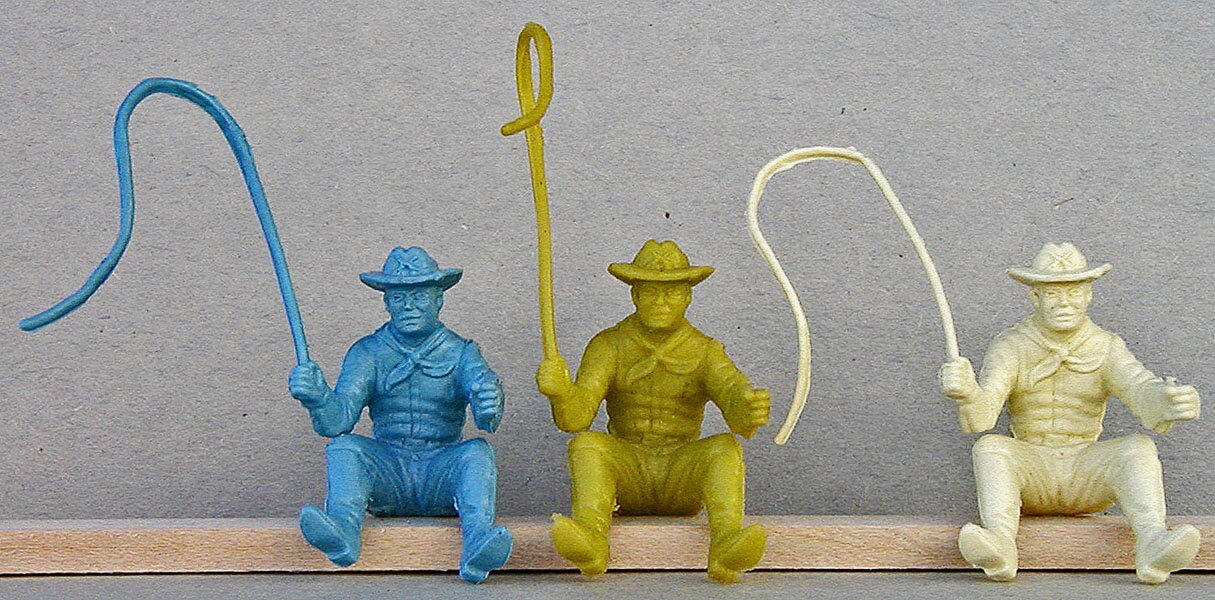 |
| 1. Wagon driver with whip -- blue, pea green, and cream |
| Recent Price Lines I have noticed | ||||
| $61 | October 2011 | Ebay | cream | |
| $56 | October 2011 | Ebay | cream | |
| $61 | March 2011 | Ebay | cream | |
| $47 | June 2012 | Ebay | cream | |
| $61 | June 2012 | Ebay | cream | |
| $47 | June 2012 | Ebay | cream | |
| $48 | May 2013 | Ebay | cream | |

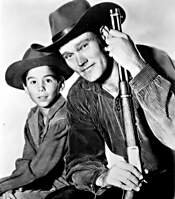 Marx' Rifleman Ranch play set was based on the television series The Rifleman, which ran from 1958 to 1963. The program told the story of New Mexico homesteader Lucas McCain working to make a living off his ranch and to raise his son Mark. Chuck Connors played the role of Lucas, and Johnny Crawford was Mark. The Marx playset was released in 1959.
Marx' Rifleman Ranch play set was based on the television series The Rifleman, which ran from 1958 to 1963. The program told the story of New Mexico homesteader Lucas McCain working to make a living off his ranch and to raise his son Mark. Chuck Connors played the role of Lucas, and Johnny Crawford was Mark. The Marx playset was released in 1959.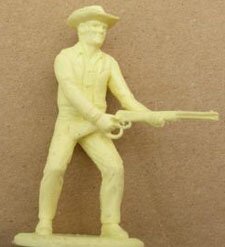 |
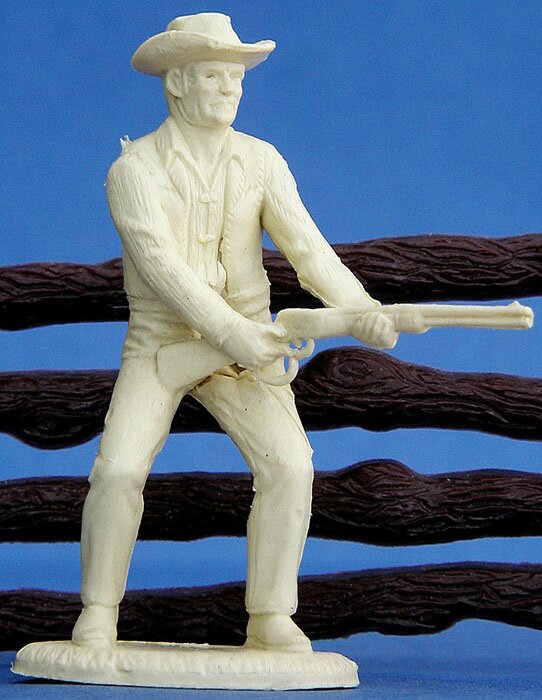 |
| 1. Lucas McCain Photo provided by Ebay's toysbill |
Lucas McCain with molding error, mostly hidden in front view |
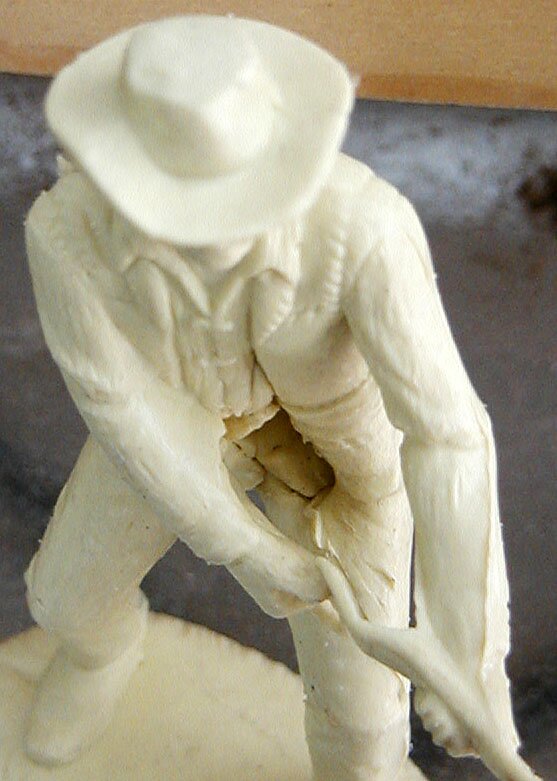 |
 |
| Common molding error on Lucas McCain figure | Oversize Lucas McCain rifle Photo provided by Dan Brogan. |
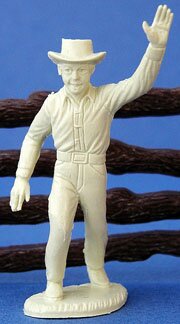 |
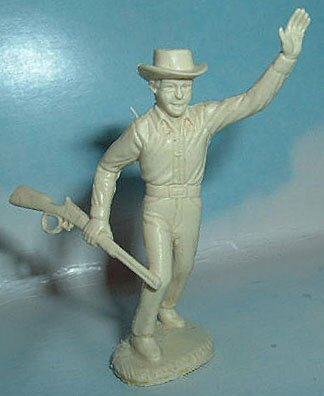 |
| 2. Mark McCain | Mark McCain with rifle Photo provided by Rick Koch, Ebay toy-hood. |
| Recent Price Lines I have noticed | ||||
| Mark | $40 | June 2011 | Ebay | |
| Mark | $31 | June 2011 | Ebay | |
| Mark | $23 | June 2011 | Ebay | mint, but misidentified |
| Mark | $52 | June 2011 | Ebay | |
| Mark | $57 | June 2011 | Ebay | |
| Lucas | $75 | Sept 2011 | Ebay | good price for buyer |
| Lucas and Mark | $139 | December 2011 | Ebay | |
| Mark | $42 | June 2013 | Ebay | |

 Marx' Gunsmoke play set -- which included character figures of the four prominent regulars on the popular television show -- was sold in 1960 and 1961. That's it. For whatever reason -- perhaps the cost of production rights -- although the long-running television show Gunsmoke debuted in 1955, Marx did not turn out its play set until the brief era of television wild west programs was already on the decline. As a result, sales were disappointing, and the play set lasted only two years.
Marx' Gunsmoke play set -- which included character figures of the four prominent regulars on the popular television show -- was sold in 1960 and 1961. That's it. For whatever reason -- perhaps the cost of production rights -- although the long-running television show Gunsmoke debuted in 1955, Marx did not turn out its play set until the brief era of television wild west programs was already on the decline. As a result, sales were disappointing, and the play set lasted only two years.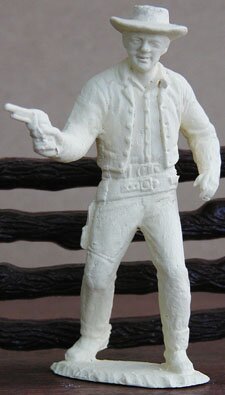 |
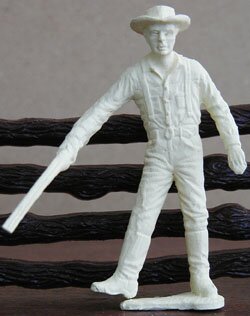 |
| 1. Matt Dillon Photo is of copy by P&P Productions |
2. Chester Photo is of copy by P&P Productions |
 |
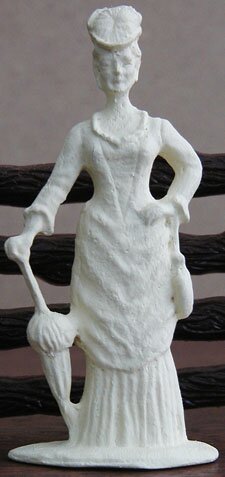 |
|
| 3. Doc Photo is of copy by P&P Productions |
4. Miss Kitty Photo is of copy by P&P Productions |
|
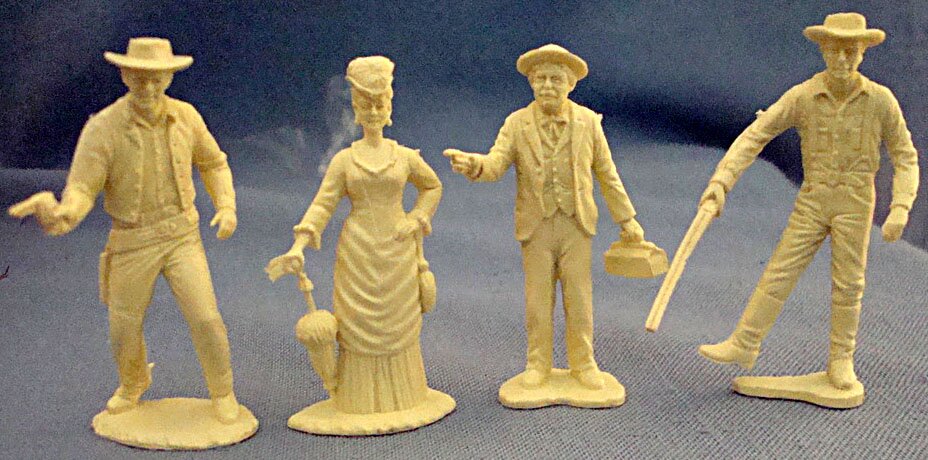 |
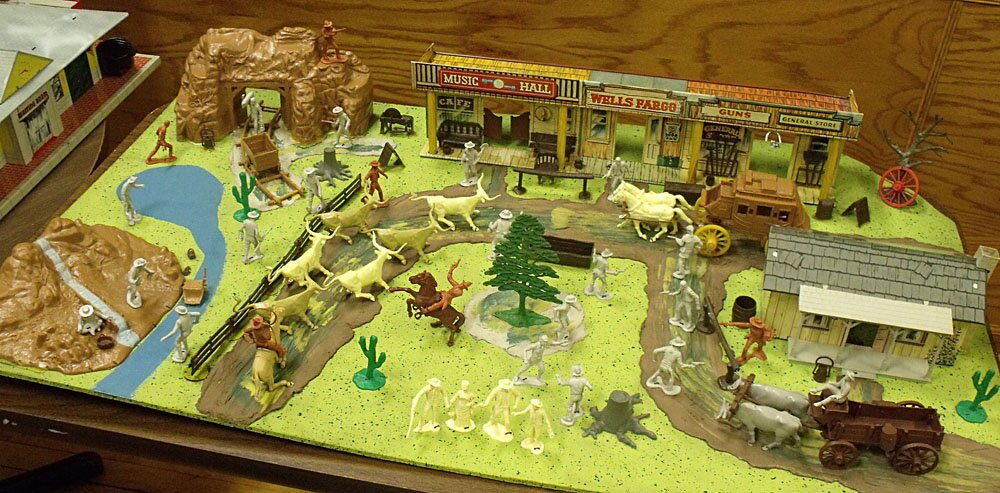 |
|
| The Gunsmoke Characters - Original Marx Photo courtesy of Bill Sanburn, Ebay ID williams7344 |
Display board used in store as advertising for playset This original Marx demonstrator board was presented by Gene Kroll at the 2011 Marx Convention. Colors of figures and accessories are not identical to those used in the final production set. |
|
| Recent Price Lines I have noticed | ||||
| Matt | $500 | February 2011 | Ebay | |
| Kitty | $230 | February 2011 | Ebay | |
| Kitty | $240 | March 2011 | Ebay | |
| Doc | $175 | February 2011 | Ebay | |
| Chester | $175 | February 2011 | Ebay | |
| Matt | $198 | July 2011 | Ebay | good condition, low price |
| Chester | $97 | July 2011 | Ebay | good condition, low price |
| Doc | $150 | Sept 2011 | Ebay | |
| Chester | $100 | Sept 2011 | Ebay | |
| Chester | $150 | November 2011 | Ebay | |
| Chester | $111 | December 2011 | Ebay | |
| Matt | $416 | December 2011 | Ebay | |
| Chester | $150 | February 2012 | Ebay | |
| All four characters | $2,025 | March 2012 | Ebay | |
| Chester | $75 | July 2012 | Ebay | Good price for buyer |

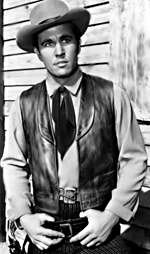 This pose may be the most dramatic of all Marx wild west figures. Today, it is definitely the rarest character figure and most expensive wild west figure that was sold by Marx.
This pose may be the most dramatic of all Marx wild west figures. Today, it is definitely the rarest character figure and most expensive wild west figure that was sold by Marx.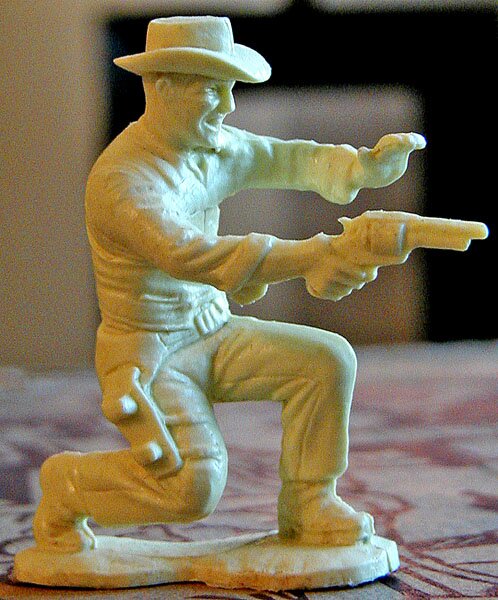 |
| Johnny Ringo Figure for photo provided by Rick Eber. |
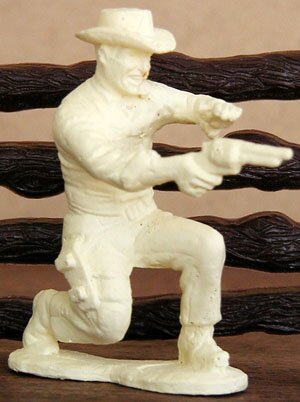 |
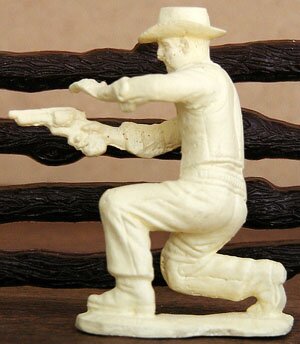 |
| 1. Johnny Ringo (front and back) Photo is of copy made by P&P Productions. |
|
| Recent Price Lines I have noticed | ||||
| Johnny Ringo figure | $2,100 | May 2011 | Ebay | good price for the seller |
| Johnny Ringo figure | $1,227 | May 2011 | Ebay | |
| Johnny Ringo figure | $1,000 | Sept 2011 | Ebay | |
| Johnny Ringo figure | $510 | October 2011 | Ebay | minor damage |
| Johnny Ringo figure | $720 | March 2012 | Ebay | excellent (23 bids) |
| Johnny Ringo figure | $850 | May 2012 | Ebay | Buy-it-now sale |

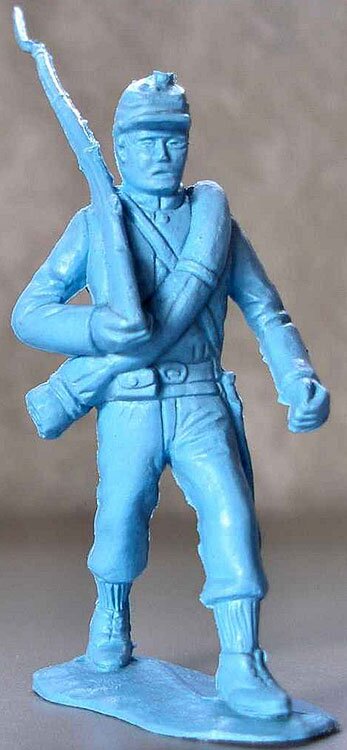 |
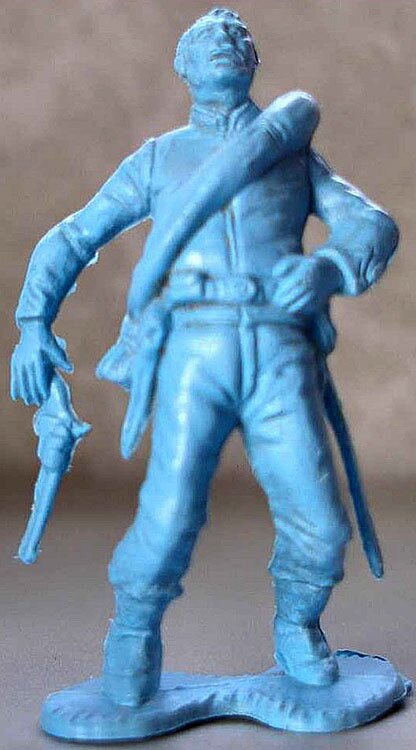 |
 |
| 1. Marching Photo courtesy of Jill and Karl Lorenz, Ebay trekrjill |
2. Shot dropping pistol Photo courtesy of Jill and Karl Lorenz, Ebay trekrjill |
3. Running with rifle Photo courtesy of Jill and Karl Lorenz, Ebay trekrjill |
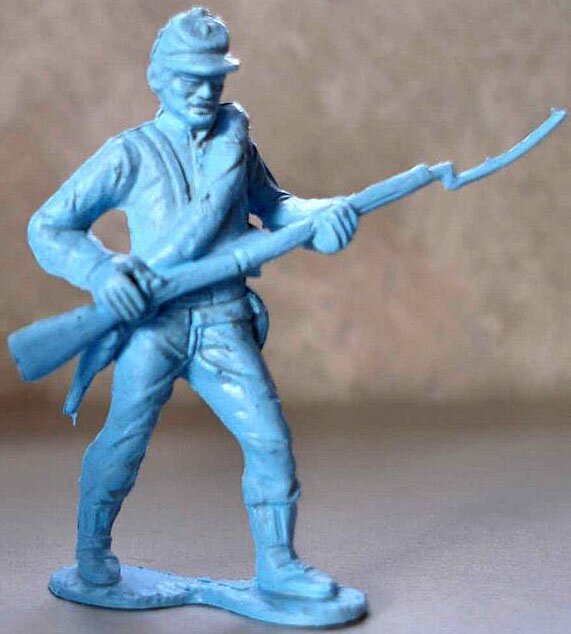 |
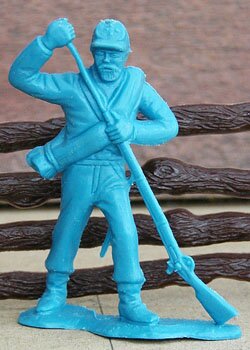 |
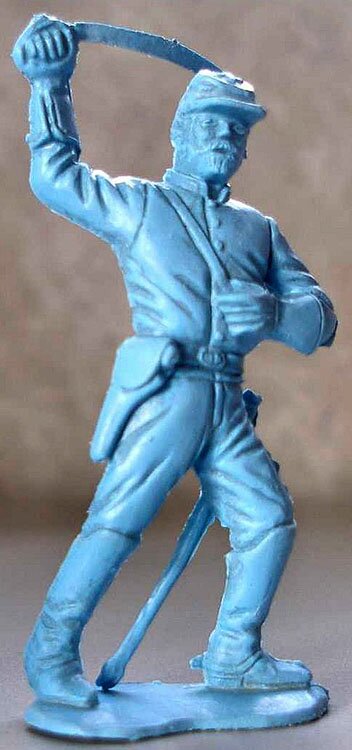 |
| 4. Advancing, rifle across waist Photo courtesy of Jill and Karl Lorenz, Ebay trekrjill |
5. Standing, reloading | 6. Officer with sword overhead Photo courtesy of Jill and Karl Lorenz, Ebay trekrjill |
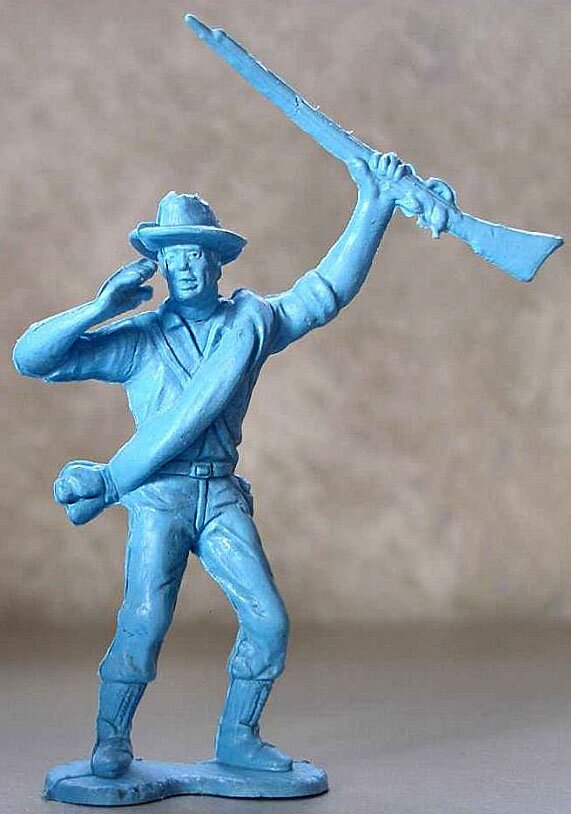 |
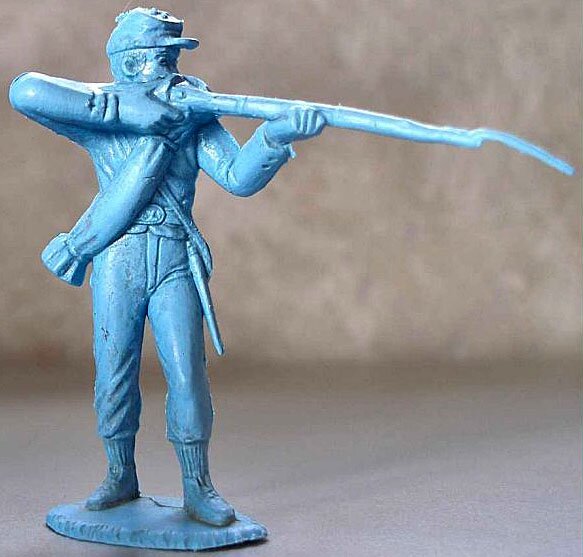 |
| 7. Calling with rifle overhead Photo courtesy of Jill and Karl Lorenz, Ebay trekrjill |
8. Standing, firing rifle Photo courtesy of Jill and Karl Lorenz, Ebay trekrjill |
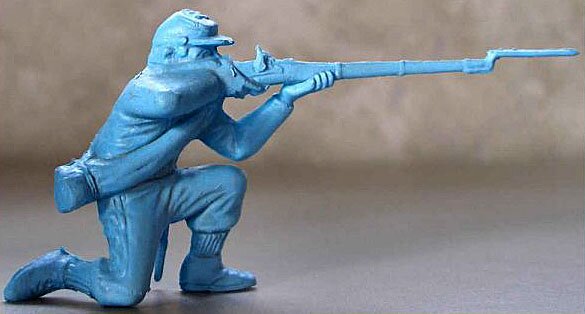 |
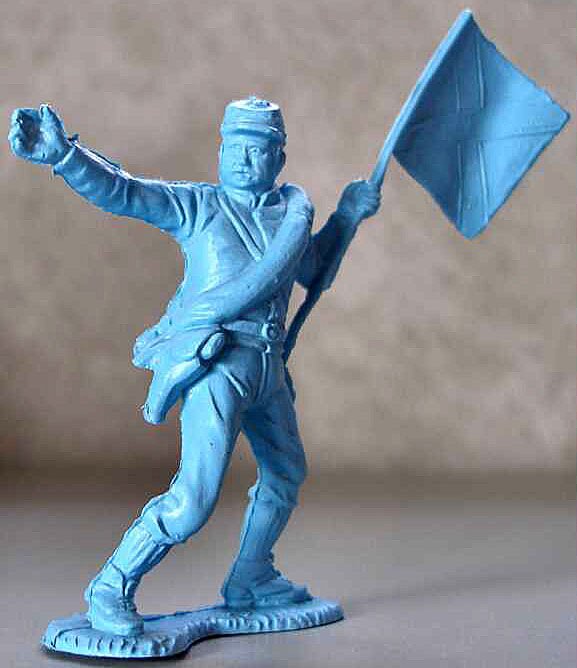 |
| 9. Kneeling, firing rifle Photo courtesy of Jill and Karl Lorenz, Ebay trekrjill |
10. Standing with flag Photo courtesy of Jill and Karl Lorenz, Ebay trekrjill |

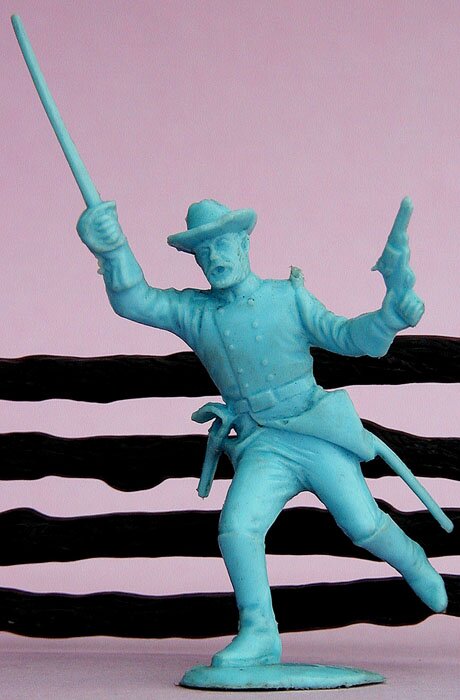 |
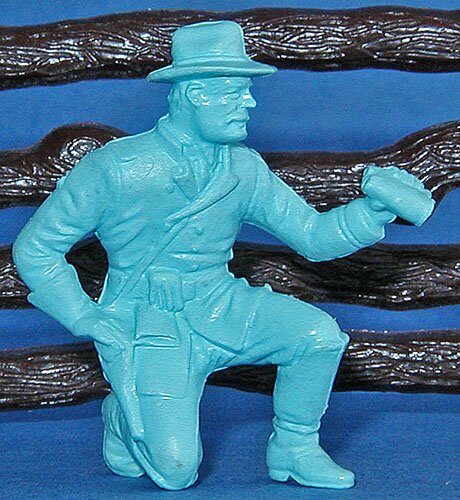 |
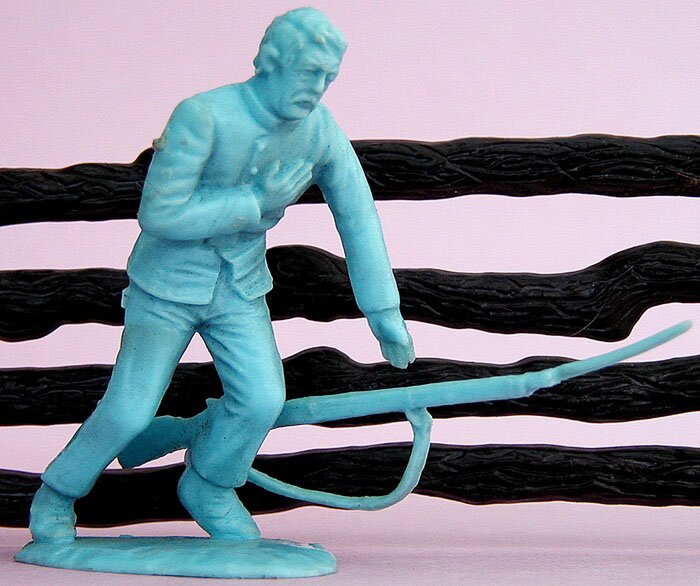 |
| 1. Officer running with sword | 2. Kneeling with binoculars | 3. Shot, dropping rifle |
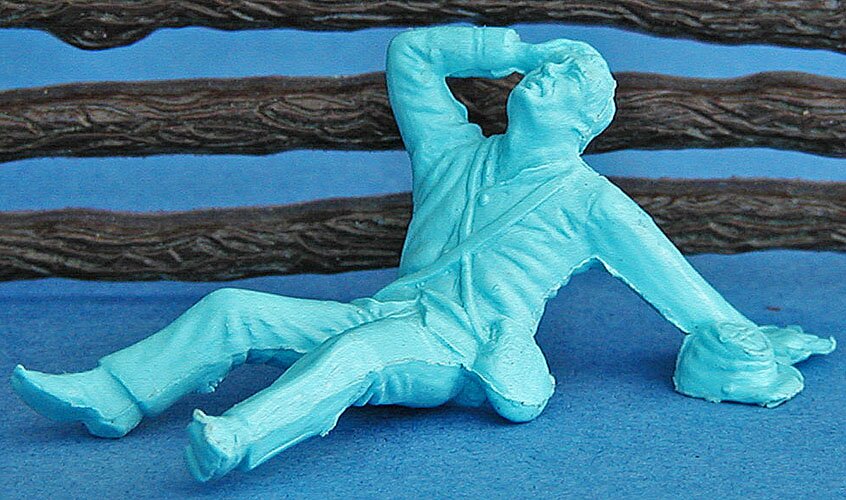 |
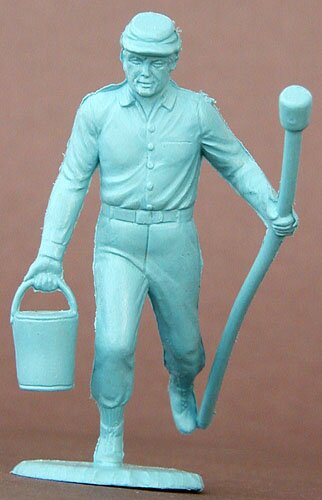 |
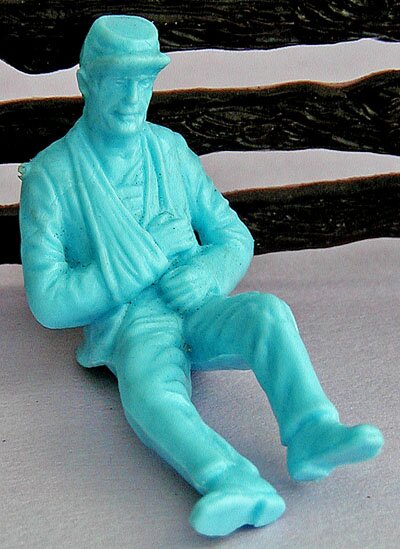 |
| 4. Sitting, head wounded | 5. Artilleryman with bucket and ramrod | 6. Sitting, arm in sling |
 |
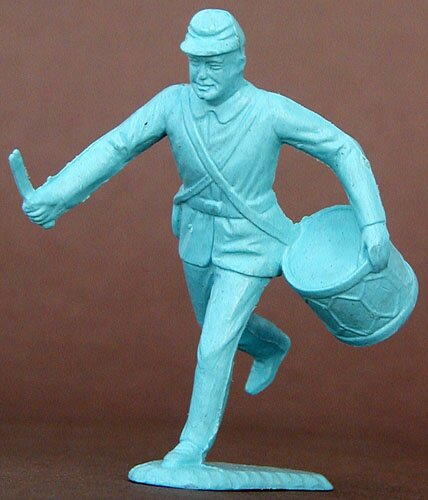 |
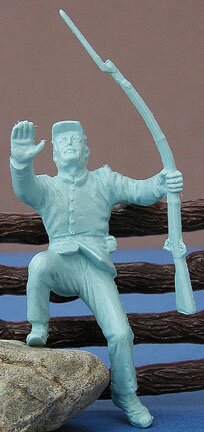 |
| 7. Clubbing | 8. Drummer (Two drum sticks held in right hand.) |
9. Crawling with rifle (Figure is shown upright.) |
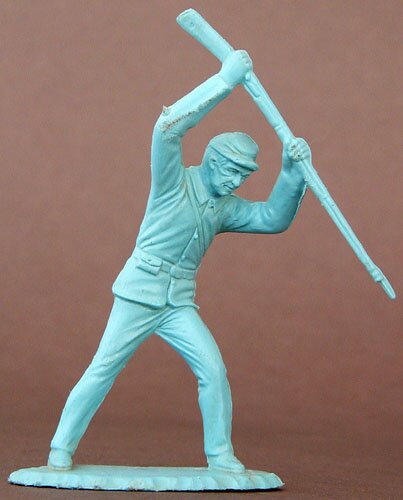 |
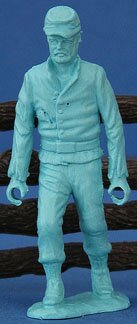 |
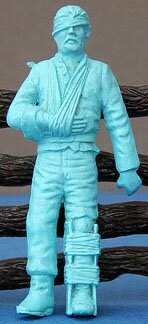 |
 |
| 10. Bayonetting | 11. Stretcher bearer |
12. Lying wounded for stretcher |
13. Stretcher |

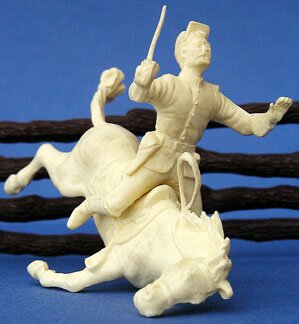 |
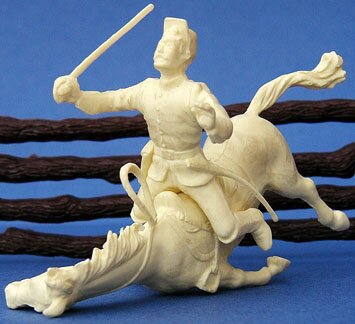 |
||
| Falling Horse and Rider Rider and horse are separate figures. |
|||
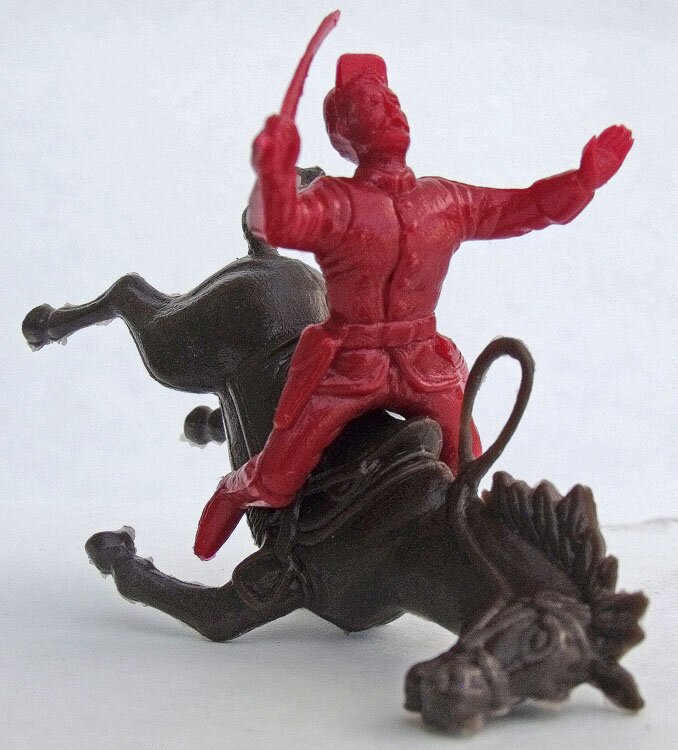 |
|||
| Falling Horse and Rider Re-issue figures made in Zouave maroon. French Zouave troops, wearing colorful uniforms, took part in the American Civil War. |
|||
| Recent Price Lines I have noticed | ||||
| $75 | March 2012 | Ebay | cream | |

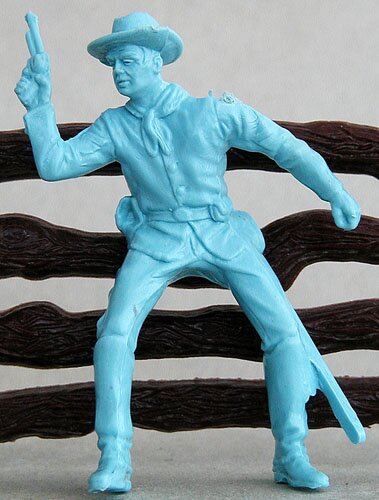 |
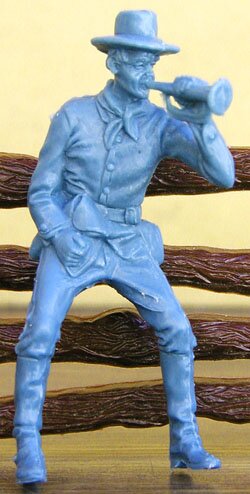 |
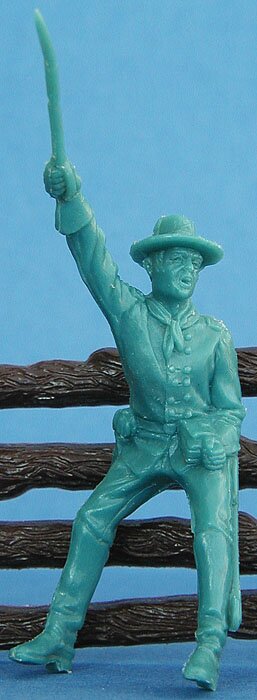 |
| 1. Mounted, pistol raised | 2. Mounted bugler | 3. Mounted, sword pointed forward |
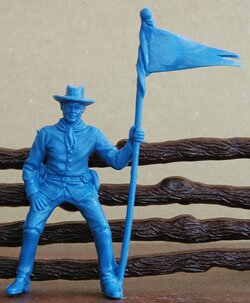 |
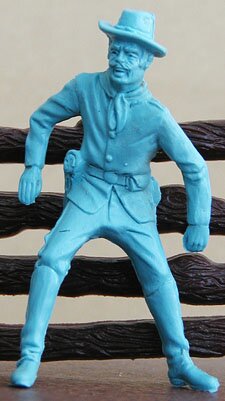 |
| 4. Mounted with flag in left hand Re-issue figure |
5. Mounted, unarmed |
| Recent Price Lines I have noticed | ||||
| Mold set of 9 figures with horses (four duplicate unarmed riders) | $172 | June 2011 | Ebay | powder blue figures |

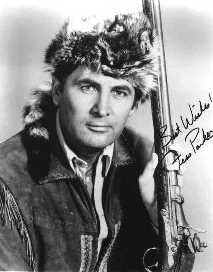 In 1964, Marx produced these nine 54mm figures for its Daniel Boone Wilderness Scout playsets, which apparently were intended to take advantage of Walt Disney's popular Daniel Boone television program, again starring Fess Parker. However, except for the name Daniel Boone, nothing in the playsets suggested any tie-in to the television show. My best guess would be that Marx created the playset hoping to negotiate a link to the Disney television series, which ran from 1964 to 1970. If so, for some reason, that did not work out. Notably, Marx did not designate any of the poses to represent Daniel Boone or Fess Parker.
In 1964, Marx produced these nine 54mm figures for its Daniel Boone Wilderness Scout playsets, which apparently were intended to take advantage of Walt Disney's popular Daniel Boone television program, again starring Fess Parker. However, except for the name Daniel Boone, nothing in the playsets suggested any tie-in to the television show. My best guess would be that Marx created the playset hoping to negotiate a link to the Disney television series, which ran from 1964 to 1970. If so, for some reason, that did not work out. Notably, Marx did not designate any of the poses to represent Daniel Boone or Fess Parker.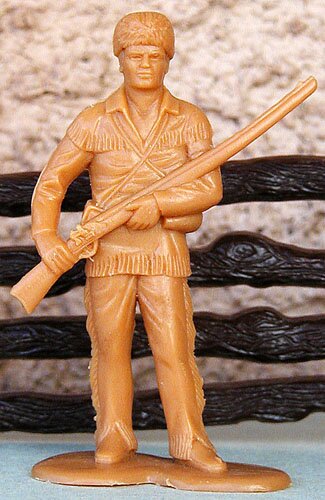 |
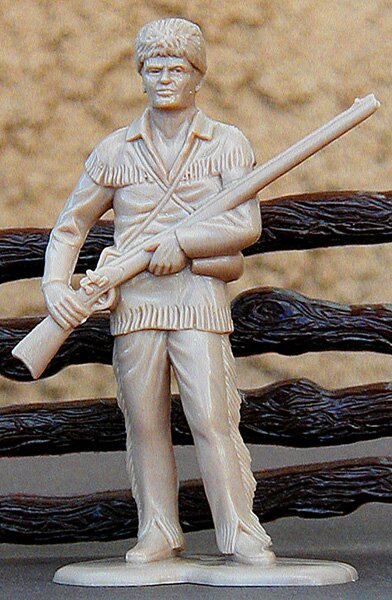 |
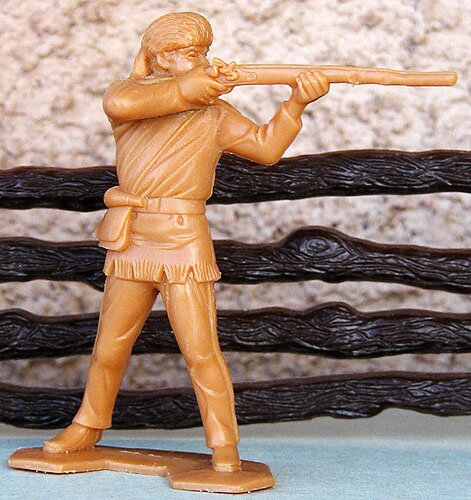 |
| 1. Standing with rifle cradled in arms (unofficial Daniel Boone) |
1. Standing with rifle cradled in arms re-issue figure |
2. Standing, firing rifle |
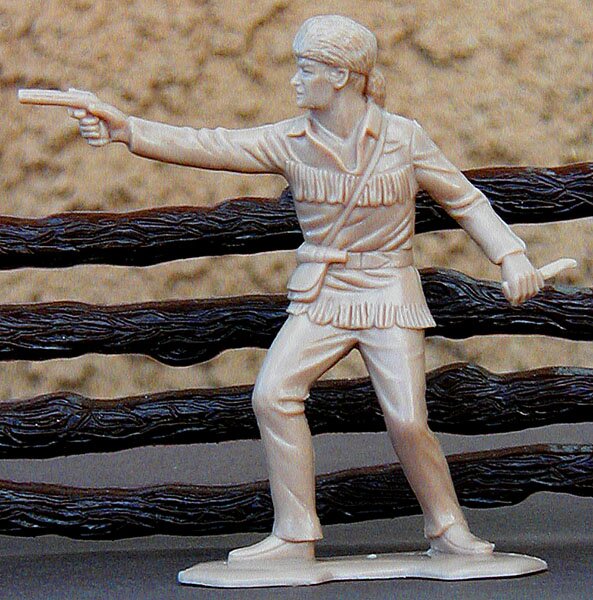 |
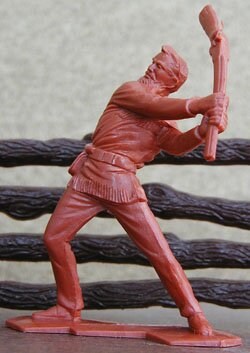 |
| 3. Standing, firing pistol re-issue figure |
4. Standing, clubbing with rifle re-issue figure |
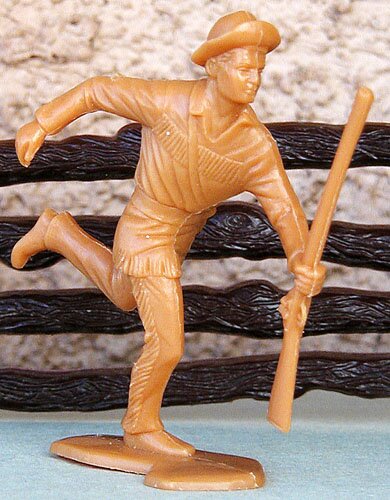 |
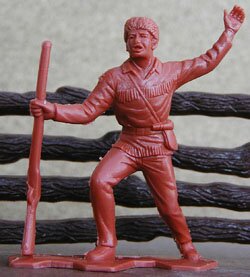 |
| 5. Running, rifle in left hand | 6. Walking, left hand raised re-issue figure |
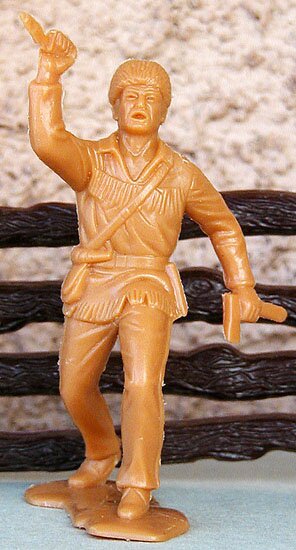 |
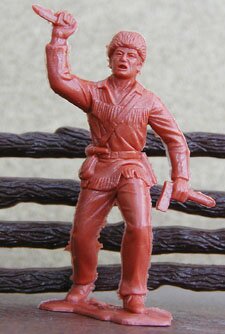 |
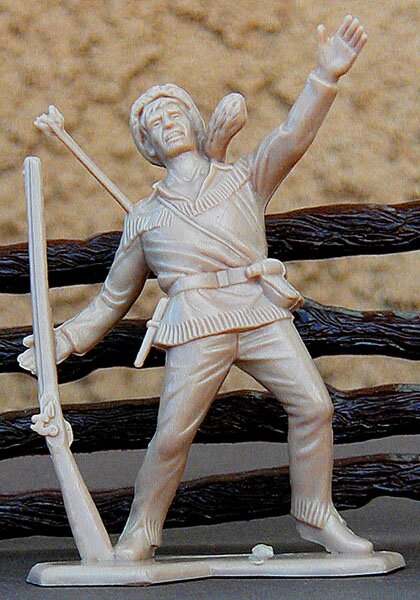 |
| 7. Attacking with knife and axe | 7. Attacking with knife and axe re-issue figure |
8. Shot with arrow re-issue figure |
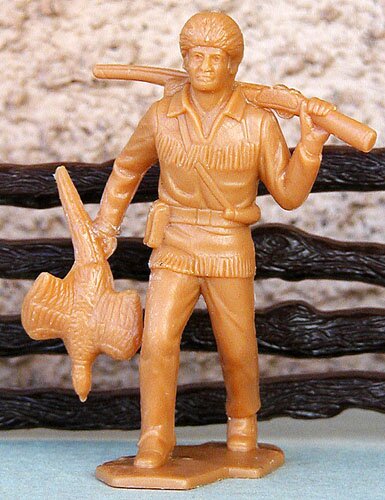 |
| 9. Walking with pheasant |

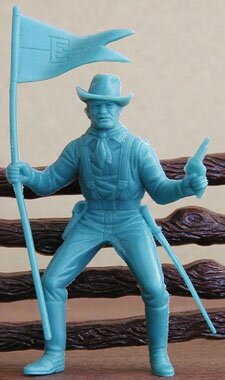 |
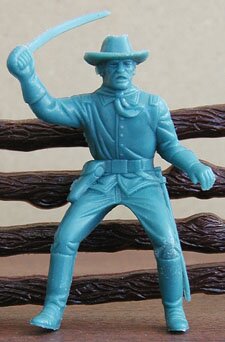 |
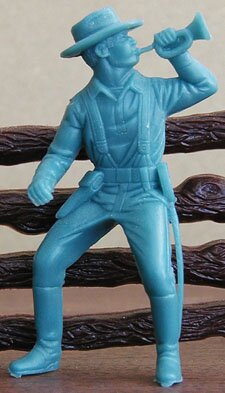 |
| 1. Mounted with flag | 2. Mounted with sword | 3. Mounted bugler |
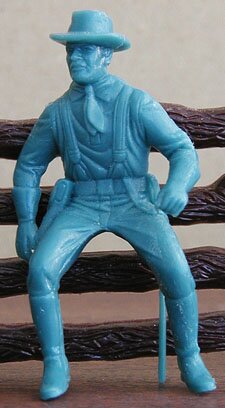 |
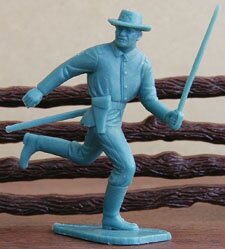 |
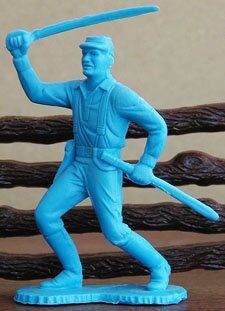 |
| 4. Mounted, arms at sides | 5. Running, sword in left hand | 6. Fighting, sword in right hand |
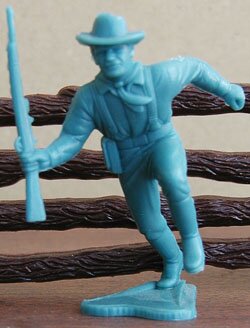 |
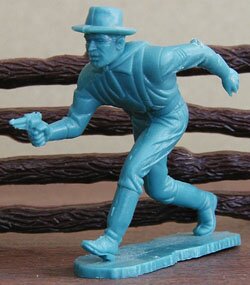 |
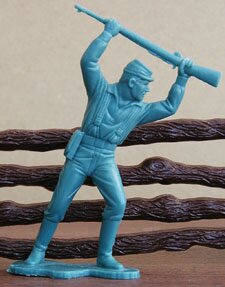 |
| 7. Running, rifle in right hand | 8. Running, pistol in right hand | 9. Clubbing with rifle |
 |
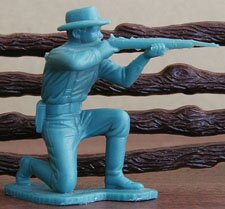 |
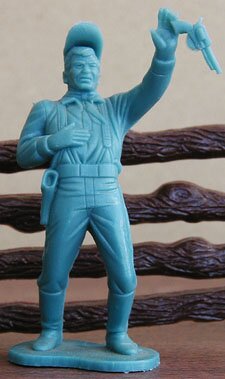 |
| 10. Standing, firing rifle | 11. Kneeling, firing rifle | 12. Shot, dropping pistol |
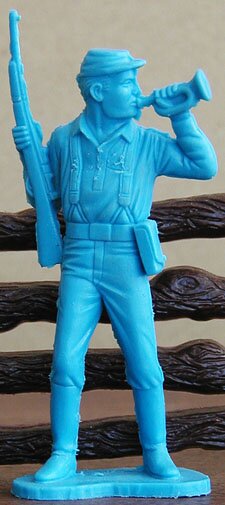 |
 |
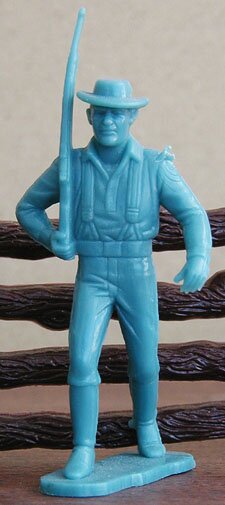 |
| 13. Standing bugler | 14. Standing with rifle across chest | 15. Walking with rifle on shoulder |
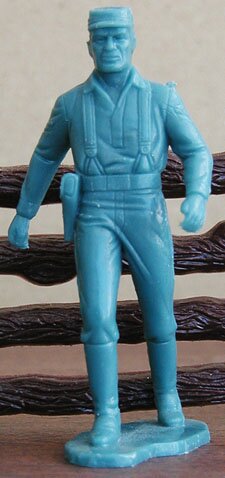 |
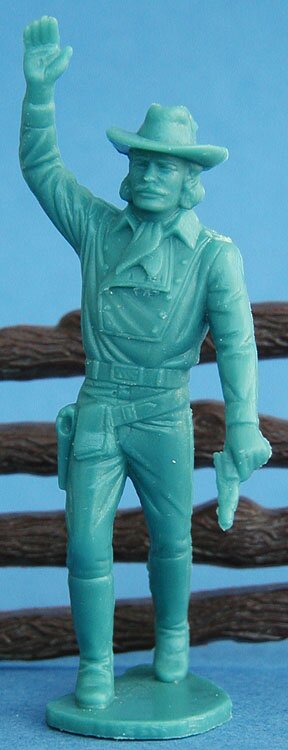 |
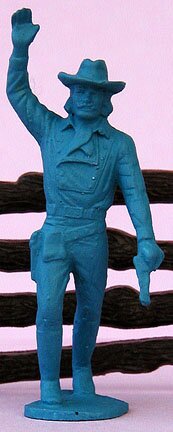 |
| 16. Walking empty handed | 17. General Custer Original in turquoise |
17. General Custer Copy made by P&P Productions |
| Recent Price Lines I have noticed | ||||
| Custer | $255 | June 2011 | Ebay | excellent condition |
| Custer | $281 | June 2011 | Ebay | |
| Custer | $405 | Sept 2011 | Ebay | light blue - from collection of the late Tom Terry, publisher of Plastic Figure and Playset Collector magazine |
| Custer | $195 | October 2011 | Ebay | excellent played with condition, good deal for the buyer |
| Custer | $238 | June 2013 | Ebay | |
